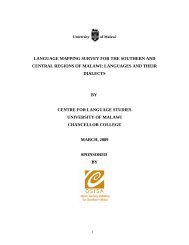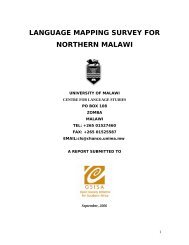SOCIOLOLINGUISTIC SURVEYS - Centre for Language Studies
SOCIOLOLINGUISTIC SURVEYS - Centre for Language Studies
SOCIOLOLINGUISTIC SURVEYS - Centre for Language Studies
You also want an ePaper? Increase the reach of your titles
YUMPU automatically turns print PDFs into web optimized ePapers that Google loves.
% Resdpondentys<br />
District Chichewa<br />
Chitumbuka<br />
Read Write Read Write<br />
Yes No Yes No Yes No Yes No<br />
Chitipa 89.4 10.6 88.6 11.4 74.2 25.8 65.2 34.8<br />
Karonga 97.6 2.4 96.0 4.0 85.5 14.5 79.0 21.0<br />
Rumphi 97.7 2.3 98.9 1.1 96.6 3.4 94.3 5.7<br />
Nkhta 94.1 5.9 92.7 7.3 62.7 28.2 57.7 38.6<br />
Bay<br />
Mzimba 90.7 9.3 89.2 10.8 90.4 9.3 87.3 12.7<br />
From Table 46 above, the pupils show high levels of literacy in both Chichewa and<br />
Chitumbuka. The results should not be entirely surprising because the languages are<br />
closely related in both structure and vocabulary. The languages, of course, belong to the<br />
same famliy of Bantu languages.<br />
The pupils were also asked to mindictae what they consider the most appropriate variety<br />
of Chitumbuka. The following results were obtained;<br />
Table 47:<br />
Chitipa<br />
Variety of Chitumbuka<br />
% Respondents<br />
Rumphi 15.2<br />
Mzimba 11.4<br />
Ngoni 4.5<br />
Henga 4.5<br />
Phoka 3.8<br />
Nthalire 3.0<br />
Nkhamanga 2.3<br />
Karonga 2.3<br />
Other<br />
less than<br />
No response 4.5<br />
Don’t know 11.4<br />
55





